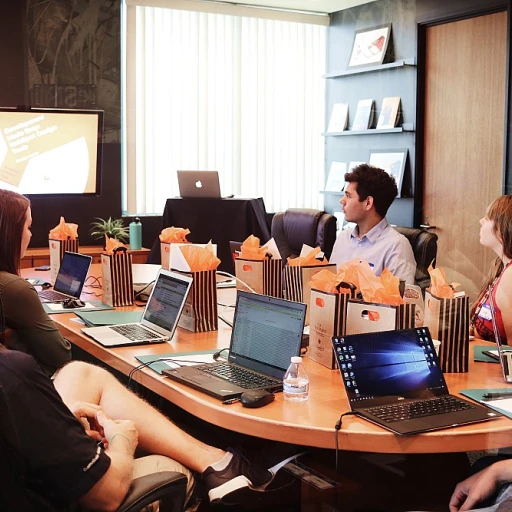Understanding Interactive Elements in the Workplace
Exploring the Core of Interactive Elements in Modern Workspaces
Interactive elements are becoming essential elements in reshaping how we approach our daily tasks and collaborations in the workplace. These elements, ranging from interactive books to digital tools, are designed to enhance engagement and productivity. In the context of modern workspaces, understanding their role is crucial for both employees and employers.
Interactive elements include a variety of tools and methods that facilitate better communication and collaboration. For instance, elements like music and engaging media are used to create a stimulating environment. This is akin to how a concert band uses carefully paced music to engage its audience. Similarly, in the workplace, interactive elements aim to create an engaging and productive atmosphere.
Moreover, platforms like the Essential Elements Interactive (EEI) provide resources such as method books and online tools that are tailored for specific needs. These resources are particularly beneficial for students and professionals alike, offering a structured approach to learning and development. The integration of these tools into the workplace can significantly enhance the learning curve and overall productivity.
However, it's important to consider the price and accessibility of these interactive elements. Just like shopping for a product, businesses must evaluate the price SKU and the value that these tools bring to their operations. The method of implementation and the support from manufacturers like EEI are also critical factors in ensuring the success of these interactive elements in the workplace.
As we delve deeper into how these elements enhance collaboration and redefine productivity, it's clear that they are not just add-ons but integral components of the modern work environment. They are akin to a band method, orchestrating various aspects of work to create a harmonious and efficient workflow.
Enhancing Collaboration Through Interactive Tools
Fostering Teamwork and Creativity
In today's evolving work environment, interactive elements play an essential role in bolstering collaboration. Tools like essential elements interactive platforms enable teams to work together seamlessly, regardless of physical location. Whether in a concert band setting or a corporate one, fostering engagement through technology is increasingly seen as vital. Consider the utilization of music carefully embedded within these platforms. Such elements provide a carefully paced rhythm to collaboration efforts, similar to how a conductor leads a band. Bringing in the engaging music of interactive book methodologies, employees or students are led through a structured yet creative pathway, enhancing their productivity and collective output. Moreover, organizations implementing interactive tools such as method books often witness an increase in team creativity. By utilizing resources like hal leonard's products, teams can access a well-curated pool of interactive elements. These resources are designed to nurture the inherent talent within each member by promoting an environment where ideas can flow more freely.Overcoming Barriers with Advanced Tools
Using advanced interactive platforms also helps overcome common barriers to collaboration. Elements book and essential elements platform offer comprehensive support for cross-departmental teams by simplifying communication channels. Through method book applications, teams can adopt the 'add to cart' approach—swiftly integrating new ideas as they emerge. The integration of these elements in professional environments bridges communication gaps often seen when shipping concepts across diverse teams. The price add of these technologies ensures that the potential for innovative collaboration is realized without excessive costs, enhancing the bottom line. For those seeking to optimize their collaborative methods, viewing these essential tools as central pillars in the workplace is crucial. They not only redefine how cooperation across teams is orchestrated but also ensure that the concert band's seamless harmony is mirrored within professional settings. To delve deeper into strategies for enhancing teamwork in virtual environments, visit our blog post on essential elements for successful virtual internships.Redefining Productivity with Interactive Technologies
Transforming Productivity in the Modern Workplace
The incorporation of interactive technologies is revolutionizing how productivity is measured and achieved within the workplace. These technologies serve as essential elements that streamline workflows and optimize output across various industries. Interactive elements, ranging from digital tools to interactive book applications, are not just buzzwords—they are integral to enhancing productivity. The integration of elements like EEI (Essential Elements Interactive) in digital projects helps employees engage more efficiently with content. These tools often include music visualization, clarinet training exercises, and even methods mimicking traditional band practice, representing companies like Hal Leonard. One such example is the utilization of music carefully integrated into workplace settings. Companies are exploring interactive elements that incorporate engaging music or sound tracks from popular music genres, curated in eei price add-ons or SKU assignments, to help maintain employee engagement throughout the day. Interactive book solutions and online platforms are also significant additions to the workplace toolkit. These digital assets, akin to an interactive book, allow workers to access essential resources like interactive band method books or method book datasets whenever they require, thereby improving efficiency and reducing downtime. Such tools enable businesses to visualize data in novel ways, encourage real-time collaboration, and cultivate a more inclusive environment. As we delve into this digital transition, it's crucial to consider the impact that these elements have on our definition of productivity beyond traditional metrics. For more insights into the future of how productivity is being reshaped, particularly through automation across industries, explore further with this informative analysis. This evolving landscape signifies a shift from merely tracking output towards fostering creativity, collaboration, and digital dexterity in employees.The Impact of Interactive Elements on Employee Engagement
Boosting Engagement with Dynamic Interaction
Interactive elements are crucial tools in enhancing employee engagement in today’s workplace. As organizations strive towards a more inclusive environment, the inclusion of dynamic tools like music, essential elements, and interactive books play a significant role in creating engaging and productive atmospheres. The use of essential interactive tools such as the "Essential Elements" book series or the Hal Leonard's "Method Book" series can offer employees a fresh perspective in learning and development. Whether it's through clarinet lessons or concert band practice, integrating popular music and carefully paced methods can significantly elevate the engagement level in corporate training sessions. Additional elements like virtual meeting ships or EEI's online platforms further enhance connectivity and engagement by offering employees interactive and engaging experiences. These platforms allow for seamless collaboration, enabling team members to add or view projects collectively, thus increasing motivation and inclusiveness within teams. Despite these benefits, organizations must be cognizant of the challenges that come with the implementation of interactive technologies. Ensuring accessibility, maintaining cost-effectiveness, and selecting the right tools tailored to the specific needs of the workplace are critical considerations. Factors such as the SKU EEI price and manufacturer EEI specifications should be taken into account to optimize the engagement strategy without incurring unnecessary costs. Ultimately, embracing these interactive elements helps to solidify an employee-centric environment, promoting continuous engagement and learning. As you consider these tools, remember to evaluate methods and products based on their effectiveness and relevance to your organizational goals. This approach not only nurtures an engaging workplace but also positions your company to adapt effectively to future trends in the world of work.Challenges and Considerations in Implementing Interactive Elements
Addressing Potential Hurdles in Interactive Workspaces
Implementing interactive elements in the workplace can revolutionize productivity and engagement, but it comes with its own set of challenges. Organizations must navigate these obstacles to harness the full potential of interactive technologies.
One of the primary considerations is the cost. Integrating advanced interactive tools often involves significant investment. Companies need to evaluate the price of these technologies, considering both initial costs and ongoing maintenance. For instance, purchasing essential interactive elements like those found in a method book or interactive music tools can be costly. Ensuring a clear return on investment is crucial.
Another challenge is the adoption of these technologies by employees. Resistance to change is a common human trait, and employees might be hesitant to embrace new tools. Training and support are essential to facilitate this transition. Providing resources such as an interactive book or a band method guide can help ease this process, making it more engaging and less daunting.
Moreover, the compatibility of new interactive elements with existing systems is vital. Organizations need to ensure that these tools integrate seamlessly with current workflows. This might involve working with manufacturers like hal leonard or eei to ensure products are compatible and meet specific needs.
Security is another critical consideration. As interactive elements become more prevalent, the risk of data breaches increases. Protecting sensitive information while using these technologies is paramount. Companies must implement robust security measures to safeguard data.
Finally, the diversity of the workforce means that interactive tools must be accessible to all. This includes considering the needs of students, concert band members, and those involved in popular music, ensuring that everyone can benefit from the technology.
In conclusion, while the integration of interactive elements in the workplace presents challenges, careful planning and consideration can help organizations overcome these hurdles. By addressing these issues, companies can create a more engaging and productive work environment.
Future Trends in Interactive Elements for Workplaces
Emerging Trends in Interactive Workspaces
The future of workspaces is being shaped by a myriad of interactive elements that promise to redefine how we engage with our environments. As technology continues to evolve, these elements become essential in creating dynamic and adaptable workspaces. Here’s a look at some of the trends that are set to influence the future of interactive work environments.
Integration of Music and Interactive Tools
Music has long been a part of the work environment, but its integration with interactive tools is gaining traction. With platforms offering engaging music experiences, workplaces are finding new ways to boost productivity and creativity. Interactive music applications, akin to a concert band setup, allow employees to collaborate in unique ways, creating an immersive work atmosphere.
Interactive Books and Learning Materials
The use of interactive books and method books in professional development is on the rise. These tools, often used by students, are now being adapted for workplace training. Publishers like Hal Leonard are leading the charge with products that combine traditional learning with interactive elements, making learning more engaging and effective.
Essential Elements for Employee Engagement
Interactive elements such as essential elements books and digital platforms are becoming crucial for employee engagement. By offering carefully paced learning modules and interactive experiences, companies can enhance employee satisfaction and retention. This approach is not just limited to traditional roles but extends to creative fields like the clarinet and other music-based professions.
Challenges in Adoption
While the benefits of interactive elements are clear, challenges remain in their adoption. Issues such as the price and SKU management of these tools can be a hurdle. Organizations need to carefully evaluate the cost-benefit ratio and ensure that these elements are seamlessly integrated into existing systems.
Looking Ahead
The future of interactive elements in the workplace is promising, with manufacturers like EEI leading the way in innovation. As the demand for interactive and engaging work environments grows, companies must be prepared to adapt and evolve. By staying informed about these trends, businesses can ensure they remain competitive in an ever-changing landscape.






